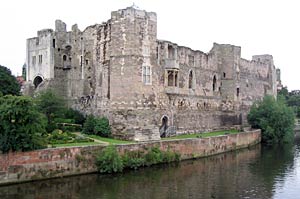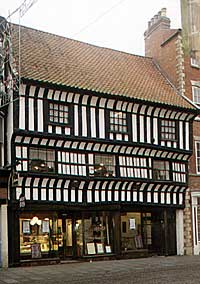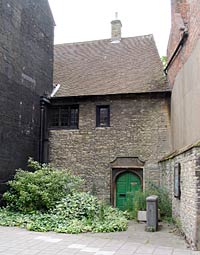< Previous | Contents | Next >
In This Castle Died King John

A panaroma of Newark in 1676.
NEWARK. A busy little Trent town still wearing its medieval dress, it is Newark because it was new work nine centuries ago, but it was probably a Roman town nine centuries before that. The Fosse Way passes through on the road to Lincoln, and the Great North Road, crossing the river here, brings a stream of motor cars instead of the old stage coach. The sound of the horn is gone, but we hear the shriek of the Flying Scotsman racing through this home of 18,000 people, and see all round the sign of active industries.
The river which once carried wool from here to Boston on its way to Calais (bringing back cloth and wine) has also seen much change. The main stream flows today by Averham and Kelham, and a branch of it still flowing in its older channel is joined by the River Devon before being canalised under the ruined castle walls. The Castle stands magnificent, one of our chief relics of antiquity.

Newark Castle in 2005.
In the days of the first King of All England the Castle was the Key to the North. In Norman days it was rebuilt by the Bishop of Lincoln. In 1216 the wretched King John came here to die after being taken ill at Swineshead Abbey. It was made a ruin in the Civil War, when Newark made its greatest contribution to the story of our land, remaining steadfastly loyal to Charles. It withstood three sieges. South of the town are the Sconce Hills, the surviving fortification of the Royalists, and one of the most perfect examples of military engineering of the Civil War.
Dominating the entrance of the town from the north, the Castle rises between the canal and a garden of green lawn with flowers and trees. The north and west walls are more or less intact, with three corner towers; another tower is in the middle of the west wall, in whose great length are many arches and windows of Norman, Gothic, and Tudor styles. Three windows here belonged to the Great Hall (altered in the 15th century when the castle was a dwelling), and the lovely oriel here has the arms of Thomas Scot, who was Bishop of Lincoln till 1480. Other remains of the Norman Castle are the splendid north-east tower with its three-arched gateway, the south-west tower in which tradition says King John died, and the crypt. In the 13th century the west wall was completed and the six-sided north-west tower was built.
It was fine, when we called, to see the red sail of a barge as we stood under the Gateway Tower. From the top of its splendid spiral stairway (which has its original roof), it was thrilling to see the pigeons wheel into the air from nooks and crannies of the ancient walls which give them shelter.
Built into the walls of the room where John is believed to have died is an ancient beam. If this were indeed his room, and if beams could hear, this might have heard him say to Faulconbridge:
The tackle of my heart is cracked and burnt,
And all the shrouds wherewith my life should sail
Are turned to one thread, one little hair:
My heart hath one poor string to stay it by.
From the Terrace Walk we go down to the fine crypt with a vaulted roof springing from a row of pillars. Here is a big collection of ancient stones (some carved with zigzag and key pattern) which once adorned the castle walls and have been rescued from the canal. Here too is a slit in a wall nearly eight feet thick, and at the end of the crypt is a passage where the sentry could keep watch on the Great North Road. Close by we can see the groove for the portcullis, for here was the watergate and a drawbridge over the moat.
The ground floor of the 13th century north-west tower was the guard room, and in its walls are fragments of zigzag and beak-heads. Down in the dungeon below it, shaped like a commodious beehive, we could feel something of the terror of the reign of King John. In that deep stone cell beyond all human hope men were chained to the walls and left to die; we can see where their hands were chained, and can peep through the narrow slot 14 feet deep through which came the last air they breathed. We climbed out by the hole through which men dragged the dead bodies.

The Governors' House in 2000.
It is pleasanter to remember the great days of the castle, when Edward the First and Henry the Sixth came here; when Elizabeth walked through these great rooms, and Cardinal Wolsey called, a tragic figure, on his way to Southwell. Much that he saw we see still, for Newark has many witnesses of those spacious days. We may wonder if any other town so small can be more rich in ancient peeps. We look through gateway after gateway, along passage after passage, and think ourselves back in the corridors of time. At the entrance to Stodman Street is the house where Governors of the Castle lived during the Civil War, with three tiers of vaulted timber overhanging the street, and black and white walls at the back. At the corner of the marketplace, by the 18th century town hall, is a glorious peep of Tudor Newark; and at another corner is what many will think the best front Newark has, with overhanging storeys and a charming gallery of 24 painted figures under canopies—gems of antiquity which were looking out across the marketplace long before the first Stuart king passed this way. Once part of the White Hart Inn but now a draper's shop, it is 14th century, one of the oldest domestic buildings in the country.
Near it is the Saracen's Head, where they say Charles Stuart slept, the inn which Scott made a resting-place for Jeanie Deans in his Heart of Midlothian. Next door is the Clinton Arms, where Byron stayed to see his first volume of poems through the press; and through its windows Mr Gladstone must have made one of his first political speeches to Newark men. Here he started that career in politics which was without a parallel for magnitude of power and length of days. Near the castle is the old Ram Inn where George Eliot stayed in 1868, and the attractive Ossington Coffee Tavern in 16th century style, built by his wife in memory of Viscount Ossington, Speaker of the House of Commons. Two old houses facing the post office in Kirk Gate, now shops under the projecting timbered storey, belonged to St Leonard's Hospital, a 12th century institution which has become one of the many charities of the town; it is thought that Henrietta Maria stayed here in 1643.

The Old Grammar School in 2005.
There are gabled houses of the 18th century, and a fine cross with a group of figures in niches round the top. Known as the Beaumond Cross, it is perhaps old enough to be one of the Eleanor crosses which marked the funeral procession of King Edward's queen from Harby to Charing Cross. In Carter Gate near by Dr Warburton, Bishop of Gloucester, is believed to have been born in 1698, son of the town clerk. Like the musician John Blow (born here and remembered as the organist of Westminster Abbey), Richard Foster Sketchley (another native and a poet on the staff of Punch), Dean Hole of Rochester, and Dr Stukely the antiquarian, Dr Warburton was educated at the grammar school founded here by Thomas Magnus, a poor boy who attracted the attention of Cardinal Wolsey and became an ambassador. Now the scholars are in new buildings, but the old school still stands facing the east end of the church, set back from the road and partly hidden by a 19th century front. It has still its fine stepped chimney stack. We enter by the old doorway, and find the Tudor schoolroom restored as it was for the Education Department, with three walls of stone and one timbered.
By it is Newark's admirably arranged museum and art gallery, with collections of local pictures forming a graphic record of the town, rubbings of the brasses in the church, pictures and notes on the association of Dean Hole and Mr Gladstone with the town, pencil sketches of Newark by William Nicholson, an original painting by Old Crome, A Woman Smoking by Gerald Dou, and a portrait of Anne Bellamy by Hoppner. Last but not least are the Roman relics from Littleborough. Concerning Mr Gladstone, there is probably no better collection anywhere illustrating his early days.
